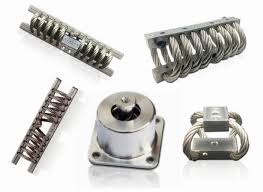Seismic isolated buildings are designed to withstand the impact of seismic events and provide maximum safety and stability for occupants. In this article, we will discuss the principles and techniques involved in designing a seismic isolated building to mitigate the effects of earthquakes and ensure rubber vibration isolators the structural integrity of the building. The goal is to create a structure that can effectively withstand the forces of a seismic event, protecting both the building and its inhabitants. We will explore the various considerations and design elements that go into creating a seismic isolated building for maximum safety and stability.
Designing a seismic isolated building for maximum safety and stability involves several key considerations. First, an in-depth understanding of the local seismic activity and ground conditions is essential in order to implement appropriate isolation systems. This requires thorough geological and geotechnical investigations to determine the potential impact of seismic events on the building. In addition, the building's structural design must incorporate specialized seismic isolation technologies, such as base isolators or sliders, to minimize the transfer of ground motion forces to the superstructure. This includes carefully selecting materials and components that can effectively absorb and dissipate seismic energy, as well as integrating flexible joints and connections to allow for relative movement between the building and its foundation. Furthermore, the layout and configuration of the building should be optimized for seismic resistance, taking into account factors such as mass distribution, building height, and lateral stiffness. Proper attention must also be given to the design of the building's non-structural elements, such as facades, partitions, and utility systems, to ensure their resilience during seismic events. Overall, designing a seismic isolated building for maximum rubber vibration isolation mounts safety and stability necessitates a comprehensive and interdisciplinary approach that involves collaboration between architects, structural engineers, geotechnical experts, and seismic isolation specialists. By carefully considering these various factors and integrating the appropriate technologies, it is possible to effectively safeguard buildings and their occupants against the potentially devastating effects of seismic activity.
Designing a seismic isolated building for maximum safety and stability involves a holistic approach to engineering and construction. It requires meticulous planning, thorough site investigation, and the implementation of advanced seismic isolation technologies. Engineers and architects work together to analyze the local seismic activity and potential ground movements, and incorporate measures to minimize the impact of earthquakes on the building structure. Seismic isolation systems, such as base isolators or sliders made of materials like laminated rubber bearings or sliding bearings, are strategically integrated into the building's foundation to absorb and dissipate seismic energy. These mechanisms allow controlled movement of the structure during an earthquake, reducing the force transmitted to the building and providing enhanced stability and safety. Additionally, the design of a seismic isolated building involves carefully considering factors such as building geometry, mass distribution, and flexible connections to accommodate building movement. The chosen structural system and materials must be well-suited for seismic resistance, and non-structural elements like facades and utility systems should be designed to withstand seismic forces. Collaboration between various disciplines like structural engineering, geotechnical engineering, and architecture is crucial to create a building that is resilient to seismic events. Furthermore, adherence to relevant building codes and standards specific to seismic design is essential to ensure the safety and stability of spring vibration isolator the structure. By taking a comprehensive approach, including advanced technology and interdisciplinary coordination, the design of a seismic isolated building can maximize safety and stability, ultimately protecting occupants and assets in the event of an earthquake.
Seismic Isolated Building: A Safe Solution for Earthquake Resistance

Seismic Isolated Building is a structural design technique that aims to protect buildings from the damaging effects of earthquakes. It involves using a system of flexible bearings or isolators to effectively decouple the building from the ground motion caused by an earthquake. This allows the building to move independently of the ground shaking, reducing the transfer of seismic forces to the structure. The use of seismic isolation technology can significantly reduce the level of damage and potential for collapse during an earthquake, making it a safe solution for earthquake resistance. Buildings designed with seismic isolation can withstand strong seismic forces and provide a high level of safety for occupants. Seismic isolated buildings have been successfully implemented in earthquake-prone regions around the world, demonstrating their effectiveness in protecting structures and saving lives during seismic events. This innovative approach to earthquake-resistant design continues to be a valuable solution for minimizing the impact of earthquakes on buildings and infrastructure.
Understanding the Benefits of Seismic Isolated Building Design

Seismic isolated building design is a method of construction that aims to minimize the damage caused by seismic activity, such as earthquakes. This design utilizes flexible bearings, sliders, or isolators to separate the building from the ground motions caused by earthquakes, thus reducing the transfer of seismic forces to the building structure. The benefits of this approach include increased safety for occupants, reduced damage to the building and its contents, and potentially lower repair costs in the event of an earthquake. Additionally, seismic isolated buildings are often able to remain functional and habitable after a seismic event, whereas traditional buildings may be rendered unsafe or uninhabitable. Overall, the use of seismic isolated building design can lead to increased resiliency in regions prone to seismic activity.
Innovative Techniques for Seismic Isolated Building Construction

Seismic isolation is a technique used in building construction to mitigate the impact of earthquakes on structures. The innovation in this technique lies in the use of bearings, sliders, or isolators to essentially decouple the building from the ground motion during an earthquake. This helps to significantly reduce the forces transmitted to the structure, therefore minimizing potential damage. One innovative technique for seismic isolated building construction is the use of lead rubber bearings (LRBs), which consist of alternating layers of rubber and steel shims encased in a steel housing with a lead plug at the center. LRBs are effective in dissipating seismic energy and are widely used in buildings, bridges, and other critical infrastructure. Another technique involves the use of base isolators, which are devices installed between the foundation and the superstructure of a building. These isolators allow the building to move independently of the ground motion, thereby reducing the seismic forces exerted on the structure. Furthermore, advancements in materials and construction techniques have led to the development of innovative seismic bracing systems, such as buckling-restrained braces (BRBs), which provide high energy dissipation capacity and ductility, enhancing the seismic performance of buildings. Overall, these innovative techniques for seismic isolated building construction have proven to be effective in improving the resilience of structures in earthquake-prone areas, ultimately ensuring the safety of occupants and minimizing potential damage.
The Importance of Seismic Isolated Building in High-Risk Areas

Seismic isolated buildings are essential in high-risk areas because they are designed to minimize the impact of earthquake-induced ground shaking. These buildings are equipped with base isolators or other flexible supports that separate the structure from the ground motion, allowing the building to move independently of the ground. This helps to prevent structural damage and collapse, protecting the lives of occupants and preserving the building for continued use. In high-risk areas, the use of seismic isolated buildings is crucial for ensuring the safety and resilience of structures against seismic activity. Additionally, these structures can help to minimize economic loss and disruption in the aftermath of an earthquake. Therefore, the importance of seismic isolated buildings in high-risk areas cannot be overstated.
Seismic Isolated Building: Saving Lives During Natural Disasters
Seismic isolated buildings are structures that are designed to withstand the lateral forces of an earthquake. They are equipped with bearings and isolators that allow the building to move independently of the ground motion, thus reducing the impact of seismic activity on the structure. These buildings are constructed with the intent of saving lives during natural disasters by minimizing the risk of collapse or serious damage. By isolating the building from the ground movement, seismic isolated buildings are able to better protect occupants and prevent the loss of life in the event of an earthquake. In addition to providing safety to occupants, seismic isolated buildings also offer the advantage of preserving the structural integrity of the building. This can result in significant cost savings by avoiding the need for extensive repairs or rebuilding in the aftermath of an earthquake. Overall, seismic isolated buildings play a crucial role in disaster preparedness and can greatly contribute to saving lives during natural disasters.
Evaluating the Performance of Seismic Isolated Building Systems
The performance of seismic isolated building systems can be evaluated through various methods, including structural analysis, dynamic testing, and simulations. These evaluations assess the effectiveness of the isolation system in reducing the building's response to seismic events. Structural analysis involves evaluating the building's response to seismic forces, while dynamic testing involves subjecting the building to simulated seismic conditions to observe its behavior. Simulations can also be used to predict the building's response to different seismic events. These evaluations help determine the overall effectiveness and reliability of the seismic isolated building system.
The Future of Construction: Seismic Isolated Buildings
The future of construction includes seismic isolated buildings, which utilize base isolators to absorb and dissipate seismic energy, protecting the structure from damage during an earthquake. This technology enhances structural resiliency and reduces the need for costly repairs and reconstruction. Seismic isolated buildings can help mitigate the impact of seismic events and improve the safety and stability of infrastructure in earthquake-prone regions. Additionally, these innovative construction methods are being increasingly adopted to safeguard buildings and ensure the well-being of occupants.
How Seismic Isolated Buildings Are Shaping Urban Development
Seismic isolated buildings are shaping urban development by providing increased safety and resilience in earthquake-prone areas. These buildings are designed to minimize the impact of seismic activity by incorporating flexible bearings or base isolators to absorb and dissipate energy. As a result, developers and city planners are able to construct taller and more innovative structures in vulnerable regions, ultimately expanding urban development and accommodating growing populations. Additionally, the implementation of seismic isolated buildings can contribute to a more sustainable and disaster-resistant urban environment.
In conclusion, designing a seismic isolated building is essential for ensuring maximum safety and stability in areas prone to earthquakes. By implementing seismic isolation techniques, buildings can be better equipped to withstand the impact of seismic activity, ultimately protecting lives and property. The use of seismic isolated building techniques is crucial in creating a resilient infrastructure that can withstand the destructive forces of earthquakes.
types of vibration isolation
See also
https://www.vibrasystems.com/products/vibration-isolation/ https://www.armstrongfluidtechnology.com/en/products/hvac-system-components/vibration-isolators https://www.vmcgroup.com/vibration-control